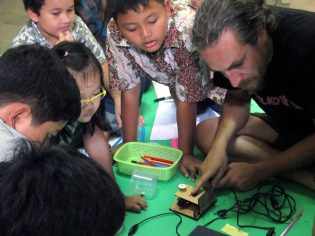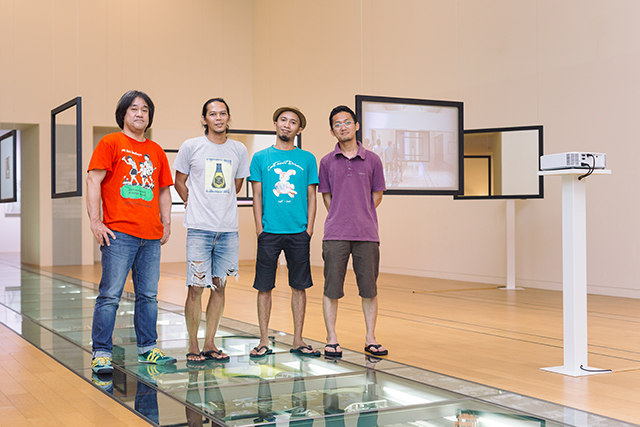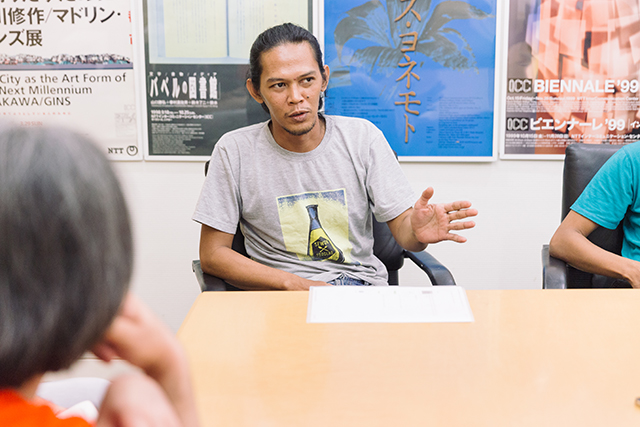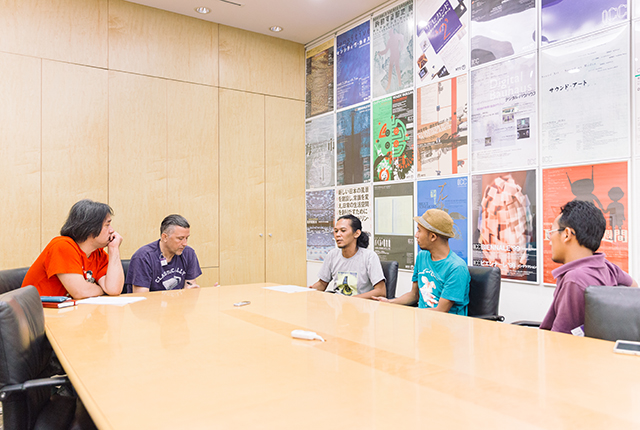DIWO: Do-It-With-Others
Hatanaka: Fascinating! The backdrop against Lifpatch's establishment, then, was Indonesia's socio-cultural conditions. So in effect we could say that there was a necessity for the breadth of technology and for each member's expertise to be added to the equation.
Akbar: Yes, that is true. Naturally, working as a group like this makes each of our expertise essential. The first time I met Timbil was when he came to my university. He had a project related to fermentation and came to find out some of the technical details. Apparently, he had some questions, and the university sent me to help them out.
We also had a workshop at my university with Andreas to make a DIY microscope *2 from a webcam. But, at the time, I didn't know that it was part of the same collective as the one Timbil was in. After that, we made lots of projects together. Basically, there's something simple that binds us together: a person who has more has an obligation to help another with less. In my case, I guess I had a little more knowledge, at that time, about fermentation. So I just simply passed on what I knew. I'm really into cellular biology and have a little more knowledge on the subject, so can help out in that field too. Basically, those are the kinds of things which I bind us together.
*2 Hackteria-DIY Microscope Webcam: Lifepatch's use of webcams and digital cameras as microscopes first came about through collaborations with Hackteria, a web platform and collection of Open Source Biological Art Projects instigated in February 2009, where its initiators held a special workshop on the use of these webcams for students of the Community Laboratory of Microbiology, Faculty of Agriculture, University of Gadjah Mada (UGM) in Yogyakarta. In 2010 Lifepatch members, led by Akbar, developed the Hackteria prototype as part of their research project. As a continuation, Lifepatch then held a workshop, targeted for elementary children, making DIY microscopes out of webcams. In this workshop, the children enjoyed assembling their own DIY microscopes—Lifepatch's original DIY kits—and learning about the water fleas and other microscopic life forms around them.


Hatanaka: So Lifepatch is essentially a network for knowledge sharing.
Andreas: Exactly! Personal access extends to collective access. When you become part of a collective, you gain certain access, and you also gain a certain visibility of society because for us, for example, how we function basically originates from the questions of our basic, daily life; the needs in our everyday lives. Timbil is working on how to make kefir milk (búlgaros, fermented milk drink made with kefir "grains")and many other fermentation methods. Me, I learned electronics from enjoying playing with synthesizers. Individually, our interests derive from our personal lives, but, when we work as a collective, we can work on larger challenges.
Of course it's DIY, but, with us in Indonesia, there is probably a stronger root of DIWO. To have a non-controlled output—specifically, to never attempt to control the output—is really interesting. Working with Timbil is like that. He will suddenly put trees in an installation. It kind of challenges you to think, "OK, so how does this change the dynamics, what do we have to do to combine everything together now in a strong concept?" Akbar, with his background in Life Science, comes up with very, very simple but practical solutions. For me, it really is an amazing experience to work with them.
Akbar: By knowing people from another background, like many of us in Lifepatch, I gained a lot of new experience outside of my own specialization. If I had stayed within my field and specific faculty and continued to study only biotechnology or agriculture, I would not have a clue of what Arduino programming or coding is, or how to use it to make an automatic system for my greenhouse, or how to build a digital microscope or other things like that. One member can teach me how to make some measurement device, how to read and log temperature data from sensors used in the university research experiment, and another member of another organization (hackteria.org) can teach me how to build DIY laminar air flow system to be used for aseptic microbiological work. So by having this network of people with different expertise, I can solve new problems. It's also good because I can meet other people, like you and ICC, by being a part of this organization. Through Lifepatch, we are also a part of a larger network of organizations outside of Indonesia. By having all of this network, we can each improve our knowledge.

NTT InterCommunication Center [ICC] (Tokyo, Japan)
Hatanaka: So interesting. So coherent, in thought and practice. To reiterate, then, your methodologies—both individual and collective, not to mention your projects—are geared towards broadening society's access to technology, whether it be finding more economical means, or by providing direct physical access. How would you define your philosophy of technology?
Timbil: Well, you have to first recognize that there are enormous developmental differences between the "North" and the "South:" we're working with what we've got. The conditions we're working in are not what you find here. We are not trying to be clever, handyman MacGyvers! *3
*3 American action-adventure television series broadcasted from 1985 to 1992. Aired in Japan in 1988. Series follows Angus MacGyver, a secret agent, whose resourceful and encyclopedic knowledge of the physical sciences, help him solve problems by making things out of ordinary, everyday objects including the famous Swiss army-knife.
Andreas: There's one more handyman who's around. God [laughs]!
Timbil: True, we're not trying to be magicians or omnipotent beings [laughs]. We are just doing what we must. For example, I want to drink safe alcohol. But, while 90 percent of the Indonesian population is Muslim—that is, moderate Muslim so we can drink beer and alcohol—a large percentage of alcohol on sale is fake and unsafe. A lot of accidents happen. That's how I met Akbar; I asked his professor to teach me how to make alcohol, and he introduced me to him. And this was the start of many projects related to fermentation. So maybe our philosophy of technology is to provide a bridge between the institutions and the laymen. Like us. Universities are filled with clever people working on specialized research, a lot of which would be more useful if it were distributed more widely. So maybe one of the things we've done is to accidentally try to build that bridge between universities, as a source of technology, and our friends, people around us, and laymen like ourselves.

Hatanaka: I imagine it must be quite interesting setting up collaborations within Lifepatch. As a collective embracing so many fields of specialization, how do you go about conceptualizing projects and putting them into practice? Could you please walk through your creative process, how is your work, how are your projects initiated and implemented?
Timbil: Usually our projects, whether it be an art and science project or a citizens project, it starts with simple ideas. If the topic is water, for example, since we each have our own previous activities that may be connected to water, we'll first discuss the exhibition, and find out who might be interested. Usually, we each simply pursue our own interests. So an invitation to an exhibition triggers us all to explore connections among ourselves. Not all of us might find connections, it may be just the two or three of us, but for small technical stuff, for example, everybody pitches in to help. So even if the exhibition is about electronics, although I know nothing about it, I can at least help with the soldering. We work like that. I am in fact quite interested in learning our process too. We have regular small events and projects that we call the Mingapa Bigini Mingapa Bigitu or MBMB in short (translated as "what is this, what is that") to simply satisfy our curiosity about how things work exactly. However, although we can work on the practical aspects, we aren't, to be honest, familiar with how to articulate its processes since the majority of us don't come from research backgrounds. So we asked our friends from several communities to work with us in how to analyze and articulate our practices, and eventually found a researcher from KUNCI Cultural Studies Center. Nevertheless, we're barely scratching the surface, so there is further work to be done to understand ourselves as a collective. But, once we figure out how exactly it is we function, it becomes another thing that we can share with the rest of the community; how collaborations work and how we can share knowledge through them.
Documentation of Mingapa Bigini Mingapa Bigitu (2015)
Hatanaka: By that, do you mean that you'd even like to open-source the language of your creative processes? I would assume that you could display the project itself as the work in exhibitions or festivals which could already be a how-to on your methodologies.
Timbil: Our practice is our language, and we develop our language through our practice. The two are indivisible. What I'm saying is that, to be honest, not many of us are skilled in describing what we are and what we do in words. Making and describing it are two very different things.
It's true that our projects and installations are shown in exhibitions and festivals, but what I want to stress is that those themselves are the language we use to explain and describe ourselves. That's our language. Sometimes, someone may understand a part of our practice, our language, and choose to articulate it and write it down in words. But, as I said, that is another entirely different practice, a different language.

- Next Page
- Artists as Problem Seekers






